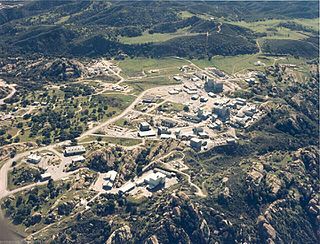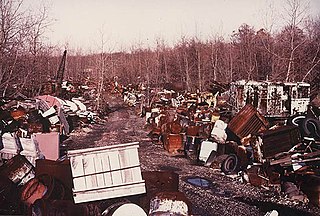
The United States federal Superfund law, officially the Comprehensive Environmental Response, Compensation, and Liability Act of 1980 (CERCLA), established the federal Superfund program, administered by the Environmental Protection Agency (EPA). The program is designed to investigate and clean up sites contaminated with hazardous substances. Sites managed under this program are referred to as "Superfund" sites. There are 40,000 federal Superfund sites across the country, and approximately 1,300 of those sites have been listed on the National Priorities List (NPL). Sites on the NPL are considered the most highly contaminated and undergo longer-term remedial investigation and remedial action (cleanups).

Environmental remediation deals with the removal of pollution or contaminants from environmental media such as soil, groundwater, sediment, or surface water. Remedial action is generally subject to an array of regulatory requirements, and may also be based on assessments of human health and ecological risks where no legislative standards exist, or where standards are advisory.

Occupational hygiene is the anticipation, recognition, evaluation, control, and confirmation of protection from hazards at work that may result in injury, illness, or affect the well being of workers. These hazards or stressors are typically divided into the categories biological, chemical, physical, ergonomic and psychosocial. The risk of a health effect from a given stressor is a function of the hazard multiplied by the exposure to the individual or group. For chemicals, the hazard can be understood by the dose response profile most often based on toxicological studies or models. Occupational hygienists work closely with toxicologists for understanding chemical hazards, physicists for physical hazards, and physicians and microbiologists for biological hazards. Environmental and occupational hygienists are considered experts in exposure science and exposure risk management. Depending on an individual's type of job, a hygienist will apply their exposure science expertise for the protection of workers, consumers and/or communities.

The Rocky Mountain Arsenal was a United States chemical weapons manufacturing center located in the Denver Metropolitan Area in Commerce City, Colorado. The site was completed December 1942, operated by the United States Army throughout the later 20th century and was controversial among local residents until its closure in 1992.

The Sydney Tar Ponds were a hazardous waste site on Cape Breton Island in Nova Scotia, Canada.
The Office of Response and Restoration (OR&R) is a program office of the National Ocean Service and a natural resource trustee that protects the coastal environment from oil and hazardous material releases and restores damage caused by such releases.
Exposure assessment is a branch of environmental science and occupational hygiene that focuses on the processes that take place at the interface between the environment containing the contaminant of interest and the organism being considered. These are the final steps in the path to release an environmental contaminant, through transport to its effect in a biological system. It tries to measure how much of a contaminant can be absorbed by an exposed target organism, in what form, at what rate and how much of the absorbed amount is actually available to produce a biological effect. Although the same general concepts apply to other organisms, the overwhelming majority of applications of exposure assessment are concerned with human health, making it an important tool in public health.

In the United States, an environmental site assessment is a report prepared for a real estate holding that identifies potential or existing environmental contamination liabilities. The analysis, often called an ESA, typically addresses both the underlying land as well as physical improvements to the property. A proportion of contaminated sites are "brownfield sites." In severe cases, brownfield sites may be added to the National Priorities List where they will be subject to the U.S. Environmental Protection Agency's Superfund program.
Soil vapor extraction (SVE) is a physical treatment process for in situ remediation of volatile contaminants in vadose zone (unsaturated) soils. SVE is based on mass transfer of contaminant from the solid (sorbed) and liquid phases into the gas phase, with subsequent collection of the gas phase contamination at extraction wells. Extracted contaminant mass in the gas phase is treated in aboveground systems. In essence, SVE is the vadose zone equivalent of the pump-and-treat technology for groundwater remediation. SVE is particularly amenable to contaminants with higher Henry’s Law constants, including various chlorinated solvents and hydrocarbons. SVE is a well-demonstrated, mature remediation technology and has been identified by the U.S. Environmental Protection Agency (EPA) as presumptive remedy.
A dense non-aqueous phase liquid or DNAPL is a denser-than-water NAPL, i.e. a liquid that is both denser than water and is immiscible in or does not dissolve in water.
The CSIR-National Environmental Engineering Research Institute (CSIR-NEERI) is a research institute created and funded by Government of India. It was established in Nagpur in the year 1958 with focus on water supply, sewage disposal, communicable diseases and to some extent on industrial pollution and occupational diseases found common in post-independent India. NEERI is a pioneer laboratory in the field of environmental science and engineering and part of Council of Scientific and Industrial Research (CSIR). NEERI has five zonal laboratories at Chennai, Delhi, Hyderabad, Kolkata and Mumbai. NEERI falls under the Ministry of Science and Technology (India) of the central government. The NEERI is an important partner organisation in India's POPs National Implementation Plan (NIP).

The Environmental Molecular Sciences Laboratory is a Department of Energy, Office of Science facility at Pacific Northwest National Laboratory in Richland, Washington, United States.

The Energy Technology Engineering Center (ETEC), was a government-owned, contractor-operated complex of industrial facilities located within the 2,850-acre (11.5 km2) Santa Susana Field Laboratory (SSFL), Ventura County, California. The ETEC specialized in non-nuclear testing of components which were designed to transfer heat from a nuclear reactor using liquid metals instead of water or gas. The center operated from 1966 to 1998. The ETEC site has been closed and is now undergoing building removal and environmental remediation by the U.S. Department of Energy.

Environmental monitoring describes the processes and activities that need to take place to characterize and monitor the quality of the environment. Environmental monitoring is used in the preparation of environmental impact assessments, as well as in many circumstances in which human activities carry a risk of harmful effects on the natural environment. All monitoring strategies and programs have reasons and justifications which are often designed to establish the current status of an environment or to establish trends in environmental parameters. In all cases, the results of monitoring will be reviewed, analyzed statistically, and published. The design of a monitoring program must therefore have regard to the final use of the data before monitoring starts.
Sustainable Remediation is a term adopted internationally and encompasses sustainable approaches, as described by the Brundtland Report, to the investigation, assessment and management of potentially contaminated land and groundwater.

The Krejci Dump was a privately owned dump occupying 47 acres (19 ha) on several sites along Hines Hill Road near Boston Heights, Summit County, Ohio. After the area was converted into part of the then-Cuyahoga Valley National Recreation Area, the National Park Service discovered that the property, part of one of the most-heavily used parks in the country, was also one of the most contaminated sites in the United States Environmental Protection Agency's Region V. The dump subsequently became a Superfund cleanup site.
A polar organic chemical integrative sampler (POCIS) is a passive sampling device which allows for the in situ collection of a time-integrated average of hydrophilic organic contaminants developed by researchers with the United States Geological Survey in Columbia, Missouri. POCIS provides a means for estimating the toxicological significance of waterborne contaminants. The POCIS sampler mimics the respiratory exposure of organisms living in the aquatic environment and can provide an understanding of bioavailable contaminants present in the system. POCIS can be deployed in a wide range of aquatic environments and is commonly used to assist in environmental monitoring studies.
Nanoremediation is the use of nanoparticles for environmental remediation. It is being explored to treat ground water, wastewater, soil, sediment, or other contaminated environmental materials. Nanoremediation is an emerging industry; by 2009, nanoremediation technologies had been documented in at least 44 cleanup sites around the world, predominantly in the United States. In Europe, nanoremediation is being investigated by the EC funded NanoRem Project. A report produced by the NanoRem consortium has identified around 70 nanoremediation projects worldwide at pilot or full scale. During nanoremediation, a nanoparticle agent must be brought into contact with the target contaminant under conditions that allow a detoxifying or immobilizing reaction. This process typically involves a pump-and-treat process or in situ application.
Water in Arkansas is an important issue encompassing the conservation, protection, management, distribution and use of the water resource in the state. Arkansas contains a mixture of groundwater and surface water, with a variety of state and federal agencies responsible for the regulation of the water resource. In accordance with agency rules, state, and federal law, the state's water treatment facilities utilize engineering, chemistry, science and technology to treat raw water from the environment to potable water standards and distribute it through water mains to homes, farms, business and industrial customers. Following use, wastewater is collected in collection and conveyance systems, decentralized sewer systems or septic tanks and treated in accordance with regulations at publicly owned treatment works (POTWs) before being discharged to the environment.
In aquatic toxicology, the sediment quality triad (SQT) approach has been used as an assessment tool to evaluate the extent of sediment degradation resulting from contaminants released due to human activity present in aquatic environments. This evaluation focuses on three main components: 1.) sediment chemistry, 2.) sediment toxicity tests using aquatic organisms, and 3.) the field effects on the benthic organisms. Often used in risk assessment, the combination of three lines of evidence can lead to a comprehensive understanding of the possible effects to the aquatic community. Although the SQT approach does not provide a cause-and-effect relationship linking concentrations of individual chemicals to adverse biological effects, it does provide an assessment of sediment quality commonly used to explain sediment characteristics quantitatively. The information provided by each portion of the SQT is unique and complementary, and the combination of these portions is necessary because no single characteristic provides comprehensive information regarding a specific site









